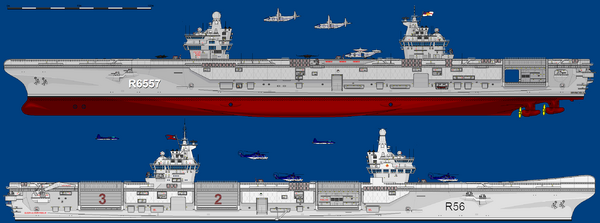Kouralian Royal Navy
| 'Tempestas de ferro in sal' | |
|---|---|
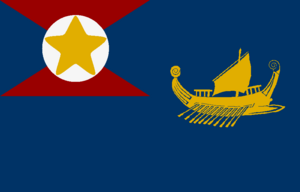 The Flag of the Kouralian Royal Navy | |
| Founded | 1600AD |
| Current form | 1960 |
| Headquarters | The Ministry of Defence (Civil HQ) RNB High Wycombe |
| Leadership | |
| Her Majesty | Queen Alyx Campbell |
| Minister of Defence | Sir Bernard Wallace |
| First Sea Lord | David Jones |
| Personnel | |
| Military age | 18-63 |
| Conscription | Not in Effect |
| Active personnel | 2,500,000 |
| Reserve personnel | 300,000 |
| Industry | |
| Domestic suppliers | Kouralian National Armoury KAE Systems (Kouralia) |
| Foreign suppliers | Crookfur Arms (Crookfur) Carthaginian Naval Export Authority (Carthaginian Republic) FDI Group |
The Kouralian Royal Navy is the Wet-Warfare Branch of the Kouralian Military and is a fully fledged Blue-Water Navy which operates throughout the Pony Lands, Mystria and further afield. Divided into the Surface Fleet, Underfleet, Auxiliary Fleet and the Skyfleet, the Royal Navy is also in a symbiotic relationship with the Royal Kouralian Army's Silverfin Guards Commandos, an amphibious-warfare, mechanised and commando light-role infantry regiment which is also a major part of the Kouralian Commando Corps.
History
Organisation
Board of the Admiralty
The Board of the Admiralty is the overall command and oversight board of the Navy. By tradition, the Navy is controlled by a single individual - the 'Lord High Admiral of Kouralia', and the Board of the Admiralty is those who nominally advise him or her on policy divisions. In actuality the 'Commissioners for Exercising the Office of Lord High Admiral of Kouralia' - both Sea Lords (senior Admirals) and Civil Lords (Civilian Officials) - make decisions of themselves. Those who sit on the board are entitled to the honorific 'The Right Honourable Lord Commissioner of the Admiralty, *Position* *Name*', for example, The Right Honourable Lord Commissioner of the Admiralty, Fifth Sea Lord Admiral Sir Benedict Roskill. In short they may be referred to as the Lords of the Admiralty. Not all members of the Board of the Admiralty are Sea Lords, however.
- Naval Lords and Admirals:
- First Sea Lord and Chief of Naval Staff
- Second Sea Lord, Vice-Chief of Naval Staff and Commander Naval Reserve
- Commander-in-Chief of the Fleet
- Third Sea Lord and Controller of the Navy
- Fourth Sea Lord and Chief of Naval Supplies
- Fifth Sea Lord and Commander-in-Chief Skyfleet
- Sixth Sea Lord and Chief of Naval Personnel & Training
- Civilian:
- Secretary of State for War
- Minister of State for the Armed Forces
- Minister for Materiel Support and Technology
- Parliamentary Under-Secretary of State for War
- Secretary of the Board of the Admiralty
- Lord Admiral of the Auxiliary Fleet
Administrative Branches
Surface Fleet
The Surface Fleet is an administrative grouping responsible for Kouralia's surface warships - from the might of the Hæleð-Class Supercarriers all the way down to the smallest coastal patrol Erika-Class. Overseen by the Commissioner of the Surface Fleet, the Surface Fleet provides the vast majority of the vessels in the Navy, and is the least specialised of the branches. The current Commander-in-Chief of the Surface Fleet is Admiral Sir David Abrahams (CINCSF).
Underfleet
The Underfleet is an administrative grouping responsible for Kouralia's military submarines - both 'Fleet' and 'Ballistic'. Seen as 'dishonourable' in traditional perception, the Underfleet nevertheless enjoys a reputation of eliteness, with only the most competent allowed to join its ranks. Unlike the Surface Fleet, commanders of individual vessels in the Underfleet will frequently work alone and separated from other supporting vessels. The current Commander-in-Chief of the Underfleet is Admiral Sir William Steele (CINCUF).
The Underfleet is especially known in the Kouralian Navy for its Submarine Command Course. This is a strenuous course which must be completed by any officer who wishes to become an Executive Officer (Second in Command) of a Fleet or Ballistic Missile Submarine. It is approximately 24 weeks long, and consists of four sections:
- The first section is training on land-based simulators.
- The second section is taken at sea and consists of tactical safety training and both consolidation and testing of the skills learned in the first stage.
- The third section returns to the simulators and shore facilities to enable the trainees to be taught both the tactical aspects (including rules of engagement, evasion measures, and interception procedures) and personnel management skills (including stress management, maintaining working conditions, and medical skills) of commanding a submarine, while learning other skills required for command.
- The final section is undertaken on a one-to-one basis between a trainer and trainee, with the trainee taking control of a submarine under full war-time conditions and completing a range of tactical scenarios in rapid succession. If a candidate at this stage fails the course, they are evacuated from the boat at the nearest practicable opportunity by boat or helicopter, and are thereafter forbidden from serving with the Underfleet in any capacity, though they are transferred to the Surface Fleet rather than being instantly dismissed from service.
Silverfin Guards Commandos
The Silverfin Guards Commando Regiment is a large section of the Kouralian Commando Corps and the second regiment in the order of precedence of the Royal Kouralian Army's Corps of Infantry. Dedicated to amphibious warfare, fleet protection and a number of other specialist tasks, as of the end of 2014 the Regiment was the largest in the Infantry, beating the Army Commando Regiment, Royal Guards and Chietan Guard Rifles. Unlike the other branches the Silverfin Guards do not come under the Commander-in-Chief of the Fleet, instead being subordinated to the Serjeant-Major General of the Army under the Commander Land Forces. The Vice-Commander-in-Chief of the Silverfin Guards, Major-General Clarence Oveur (VCINCSG) does however traditionally work closely with the CINCSF.
Operational Deployment
The Royal Navy operates on a number of levels, each commanded by an Officer of a particular rank. Officers of Lieutenant to Captain will invariably command single vessels, though above that are the 'flag' ranks, or Officers who command formations.
- The Navy means the entire Kouralian Navy, the professional head of which is the Lord High Admiral, and the Operational Head of which is the Commander-in-Chief of the Fleet.
- The Fleet is usually commanded by the Commander-In-Chief of the Fleet and consists of all Kouralian Battle Fleets put to sea at a time. 'Fleet' is also a term used to refer to any grouping of multiple Battle Fleets to undertake a task. This formation will usually be commanded by an Admiral also.
- The Battle Fleet is usually commanded by a Vice-Admiral, and is a collection of Squadrons intended to impose Command of the Sea on a particular geographic area, with support from Auxiliary and Amphibious Squadrons to maintain itself for sustained operations. The Battle Fleet is the independent building block of the Kouralian Navy.
- The Squadron is usually commanded by a Rear-Admiral, and is a formation of ships of the line and escorts directed to a specific task. Usually this is synonymous with a 'Carrier Battlegroup', and the Commodore will operate from the carrier as his flagship.
- The Flotilla is usually commanded by a Captain, and is usually a semi-independent formation of escort vessels of the same type. For example, a Minesweeper Flotilla or an Anti-Submarine Frigate Flotilla.
- The Division is an administrative grouping of a Squadron or Flotilla, usually commanded by a Commodore if it contains capital ships, or a Captain if it does not. For example, a Destroyer and two Frigates may make up the Air Defence Division of a Squadron.
- Stone Frigates, or Shore Establishments are commanded by 'Port Admirals', of one of a number of ranks. The largest Establishments, such as HMNB Wanderer, are commanded by an Admiral-Superintendent of as high a rank as Vice-Admiral. Other establishments are commanded by Admirals-, Commodores- or Captains-Superintendent, and are usually assisted by a Captain of the Port who acts as the Queen's Harbourmaster. All Stone Frigates come under the purview of the Sixth Sea Lord.
Deployed Forces
A Battle Fleet is the usual formation deployed to a particular area to establish Kouralian control or protect the Union's interests. This Battle Fleet will inevitably consist of three Squadrons (Coloured 'Red', 'White' and 'Blue) based around a Carrier. Three more units support this formation as standard - one being an Underflotilla of vessels of the Underfleet, one being an Amphibious Warfare Squadron based around three Amphibious Warfare vessels and one being a Command and Support Squadron which acts in a Combat Support Services Role. In addition to these Squadrons, other flotillas may be attached to the Battle Fleet, for example further Air Defence Flotillas or Minehunter Flotillas in order to match operational requirements.
More information is available about the makeup of Kouralian Battlefleets.
Landing Forces
The Royal Navy - perhaps, for those who do not know Kouralia well, surprisingly has a strong tradition of land combat in its veins. Not only do most vessels carry a detachment of the Army's Silverfin Guards Regiment, but all sailors are trained in basic small-unit tactics and dismounted combat, able to form 'Shore Parties' and 'Landing Parties'. The latter of those is a term used by the Kouralian Navy to refer to anything which is deployed for non-combat purposes, for example marshals in the landing zone, distribution of aid or management of any other than warfare effort. The former, 'Shore Parties' refer to those landed for the express purpose of warfighting, taking and holding, or capturing ground. Both Shore and Landing Parties are different things to a Naval Regulatior Shore Patrol.
A Party will usually be commanded by an Officer from Sub-Lieutenant to Lieutenant-Commander, depending on its size. The size will also depend on the number and size of vessels contributing to it. A Sloop of War may only send a Petty Officer and ten men ashore to perform tasks, whereas a full Coloured Squadron of a Battle Fleet could dispatch a Battalion-strength of men (not including the Silverfin Detachments) under a Commander. While not able to muster the same quantity of mortars, missiles and other support weapons that an equivalent Army unit could deploy, this still represents a potent force which allows the navy to act rapidly in emergencies.
The Naval Regulating Branch is the Service Police formation for the Kouralian Royal Navy. Due to the lack of civilian law enforcement or investigative capabilities assigned to the Ministry of War, the NRB is the only law enforcement organisation for the Kouralian Navy. Many members of the Naval Regulating Branch are enlisted, and Commissioned officers only have the role of managers - they are usually Late Entry Officers who have served as Regulators previously. Sailors of the NRB are referred to as 'Regulators', and upon completion of training in-rate at the Naval Regulation Academy they are given the rank of Leading Rate.
| Rate (Rank) | Regulator Rating | Abbreviation | Time in service |
|---|---|---|---|
| Leading Rate | (Leading) Regulator | LRg | 1-4yrs |
| Petty Officer | First Regulator | FRg | 4-8yrs |
| Chief Petty Officer | Chief Regulator | CRg | 8-15yrs |
| Warrant Officer II (not seniormost) |
Master Regulator | MRg | 15-25yrs |
| Warrant Officer I (seniormost) |
Master-At-Arms | MAA | 25yrs+ |
Naval Regulators have presence on every naval warship from Corvette upward, where they are responsible for maintaining discpline, investigating infractions and crimes, providing a cadre of dismounted combat-trained silors for shore parties, and controlling the vessel's armomoury. On ships the seniormost Regulator will be a Master-Ar-Arms, though a battlefleet will likely have a Regulatory Officer of the rank Lieutenant or higher assigned to its admiral's staff. There are many roles within the Naval Regulating Branch, including dog handlers, specialist firearms cadres, and Special Regulators of the Investigatory Regulating Department whose job is to investigate major crimes such as murder, rape, serious security breaches and espionage. Even within this role, all operational tasks are undertaken by enlisted sailors, with minimal requirement to seek authority from commissioned officers. As its members are among the most extensively trained in dismounted combat, its members make up one of the largest proportions of Sailors joining the Swimmer-Canoeist Regiment.
Equipment
Surface Fleet
Aircraft Carriers
| Class | Origin | Image | Stats | Details |
|---|---|---|---|---|
Fleet Supercarrier 30 Hulls |
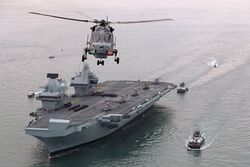 RKNV Queen Alyx-En-Fidelis |
Displacement: 172,305 tons Length Overall: 424.2m Beam: 80.1m Depth: 12.5m Complement: 1,550 Air Crew: 3,000 Speed: 35kts Sustainable Range: Unlimited |
The Hero-Class of Fleet Supercarriers make up the main offensive power of Kouralian fleets at sea, with delivery from the Freestian FDI Group beginning in 2015 and ending in 2018. They are highly modernised twin-island carriers designed to operate STOVL fixed-wing aircraft at a high operational tempo, with a huge Embarked Aviation Group of 130 airframes to support this. Commanded by Captains, they are the flagships of their Battlesquadrons, though are usually not the Battlefleet's Flagship due to their priority as a target. | |
Light Carrier 30 Hulls |
 RKNV Father-Of-The-House |
Displacement: 22,000 tons Length Overall: 209m Beam: 36m Depth: 8m Complement:650 Air Crew: 350 Speed: 18kts Sustainable Range: 8,100 Miles |
The Senator-Class were originally the only serious aviation assets for the Kouralian Navy until the Fleet Carrier Project bore the fruits of the Hero-Class. They are significantly smaller and older than the Hero-Class - carrying only 21 Airframes, but can still undertake fully independent defensive and offensive ASaC, ASW and ASuW aviation operations.
These Ships are commanded by Captains. | |
Aviation Cruiser 69 Hulls |
 RKNV Fireball |
Displacement: 14,150 tons Length Overall: 180.2m Beam: 33.4m Depth: 8.2m Complement: 550 Air Crew: 180 Speed: 30kts Sustainable Range: 8,100 miles |
Significantly smaller and with significantly less capability, the Magic-Class of Flight-Deck Cruisers are intended to act as screening escorts and redundancy hulls for the aviation assets of any Kouralian battlefleet. They can operate STOVL craft, but are usually restricted to rotary-wing air operations, being able to operate limited ASW, ASuW and ASaC capabilities with their complement of 18 Airframes.
These ships are commanded by Captains. A number of these ships operate independently as the lead ships of the Kouralian Navy's Coastal Command's Extended-Range Interdiction Areas. |
Amphibious Warfare Ships
| Class | Origin | Image | Stats | Details |
|---|---|---|---|---|
Landing Platform Helicopter 30 Hulls |
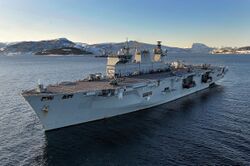 KCS Leopard in on exercise in Malgrave |
Displacement: 21,500 tons Length Overall: 203.4m Beam: 35m Depth: 6.5m Complement: 460+830 Speed: 18kts Sustainable Range: 8,000 miles |
The Lord-Class | |
Landing Platform/Dock 30 Hulls |
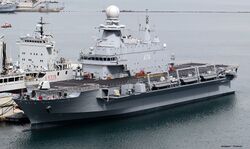 KCS Fauchard in port |
Displacement: 8,800 tons Length Overall: 142.9m Beam: 21.5m Depth: 5.3m Complement: 152+430 Speed: 20kts Sustainable Range: 7,000 miles |
The Sword-Class | |
Landing Platform/Dock 30 Hulls |
 KCS Tower at sea |
Displacement: 19,560 tons Length Overall: 176m Beam: 28.9m Depth: 7.1 Complement: 325+405 Speed: 18kts Sustainable Range: 8,000 miles |
The Castle-Class | |
Dock Landing Ship 30 Hulls |
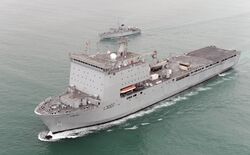 KCS Færyello at sea |
Displacement: 16,160 tons Length Overall: 176.6m Beam: 26.4m Depth: 5.8m Complement: 150+500 Speed: 18kts Sustainable Range: 8,000 miles |
The Mountain-Class |
Guided Missile Cruisers
| Class | Origin | Image | Stats | Details |
|---|---|---|---|---|
Guided Missile Cruiser 30 Hulls |
 Diagramatic View of RKNV Temeraire |
Displacement: 23,405 tons Length Overall: 224.2m Beam: 60.1m Depth: 12.5m Complement: 230 Speed: 39kts Sustainable Range: Unlimited |
The Temeraire-Class of Guided Missile Cruisers from the Freestian FDI Group were supplied in conjunction with the Hero-Class's deal. They act as missile-carrying support ships which can tackle targets at sea, on land and in the air. They are commanded by Captains and are usually Battlefleet Flagships. |
Escorts
| Class | Origin | Image | Stats | Details |
|---|---|---|---|---|
| Air Defence | ||||
Guided Missile Destroyer ?? Hulls |
 RKNV Vygean at port in Malgrave |
Displacement: 7,050 t Length Overall: 152.87 m Beam: 20.3m Depth: 5.4m Complement: 236 Speed: 29kts Sustainable Range: 6,100 Miles |
The Prefect Class was intended as the replacement for the Prince-Class and is significantly higher tech, with far more powerful sensors and much greater automisation. The ship has 8 Anti-Surface Missiles, a 48-cell Anti-Air VLS System, 3 76mm guns, 2 single-tubes for torpedoes with 24 carried, and 2 25mm automatic cannons. The vessel features no CIWS, though the 76mm guns can fulfil that role. The vessel can carry one medium-sized helicopter. | |
Guided Missile Destroyer ?? Hulls |
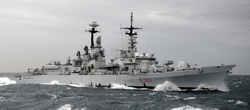 RKNV Palatine |
Displacement: 4,500 t Length Overall: 147m Beam: 16.1m Depth: 5m Complement: 380 Speed: 32kts Sustainable Range: 7,000 Miles |
The Prince-Class of Anti-Air Escorts are currently legacy vessels, which only avoided complete phasing out due to the expense of the Prefect-Vessel Programme. They are heavily armed vessels, with one main 155mm gun and three 76mm guns, 4 Surface-to-Surface missiles, a number of SAM missile Launchers, and two triple torpedo launchers. The vessel features no CIWS, though the 76mm guns can fulfil that role. The high concentration of armaments on a small hull necessitates the high crew count compared to other ships. The vessel can carry two small helicopters. | |
| Anti-Submarine Warfare | ||||
ASW Frigate ?? Hulls |
 RKNV Prosecutor firing main gun |
Displacement: 4,900 t Length Overall: 133m Beam: 16.1m Depth: 7.3m Complement: 185 Speed: 28kts Sustainable Range: 7,500 Miles |
||
| General Purpose | ||||
Frigate ?? Hulls |
 Diagramatic View of RKNV Emancipare |
Displacement: 3,400 t Length Overall: 120.2m Beam: 15.2m Depth: 5.2m Complement: 85 Speed: 25kts Sustainable Range: 7,400 Miles |
Like other Freethinker vessels in service with the Kouralian Navy, the Freedom-Class are the most modern vessels in service, and make great use of automation and digital design to decrease the crew requirements. The vessels are smaller and less capable than designated AA and ASW escorts, however the modernisation helps them bridge the gap and provide economical general purpose support to the fleet. Each vessel has a 155mm gun in the bow for shore gunnery, and two quad launchers for the standard anti-surface missile. A 16-cell OceanCeptor VLS is installed behind the gun, as is a Rolling AIrframe Missile CIWS above the hangar. Also installed are torpedo catapults and manual guns for countering smallcraft and port-defence. | |
Corvettes and Patrol-craft
Logistical Support Craft
Smallcraft
| Class | Origin | Image | Stats | Details |
|---|---|---|---|---|
| Landing Craft | ||||
Landing Craft Vehicle Personnel |
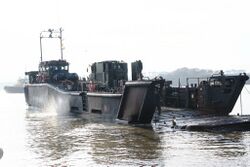 LCU landing vehicles |
Displacement: 240 t Length Overall: 29.82 m Beam: 7.70m Depth: 7.70m Complement: 7+120 Speed: 19kts (Full) 40kts (Empty) Range: 600 Miles |
The Kouralian LCU No.7 is a 'Partial Air Cushion Supported CATamaran' fast landing craft capable of carrying a full MBT to shore rapidly. Alternatively it can carry as many as four APCs, or a company of marines to shore | |
Landing Craft Vehicle Personnel |
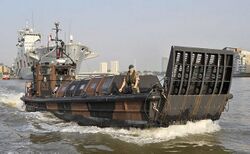 LCVP transiting Kurton |
Displacement: 24 t Length Overall: 15.7 m Beam: 4.3m Complement: 3+35 Speed: 25kts (Full) Range: 240 Miles |
The LCVP is a smaller landing craft intended for carrying a platoon of marines or a small vehicle to shore. Four of them can carry a full company of marines to shore. It can be equipped with a pair of GPMGs mounted at the front to provide suppressing fire as it lands people. | |
| Special Warfare Craft | ||||
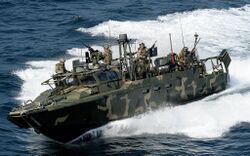 LCVP transiting Kurton |
Displacement: 15.3 t Length Overall: 15.9 m Beam: 3.8m Depth: 0.8m Complement: 3+18 Speed: 40kts (Full) Range: 270 Miles |
The F/LAC is a smaller, faster, and more heavily armed boat which is able to carry roughly half a platoon of men to shore. It can be equipped with up to four side-facing pintle mounts for weapons, and a central heavier weapon system such as an auto-cannon RCWS or a GMG mount. It can also deploy two jet skis, 4 sea mines, or six depth charges from rear racks. | ||
 ORC Landing troops on exercise in Malgrave |
Displacement: 4.7t(full) Length Overall: 9.1m Beam: 2,9m Depth: 0.69m Complement: 3+12 Speed: 32kts (Full) Range: 230 miles |
The Offshore Raiding Craft is a small boat used for patrol and troop insertion - traditionally for strategic reconnaissance such as landing beach assessment parties. It can be equipped with armouring panels and had three pintle mounts for machine guns. | ||
 RRC transiting Kurton |
Displacement: 2.5t(full) Length Overall: 6.5m Beam: 1.9m Complement: 11 Speed: 33kts (Full) Range: 100 miles |
The Rigid Raiding Craft is a small boat used to carry men around rivers, between ships and shore, and to patrol shore establishments. | ||
Inflatable boat |
 IRC Transiting jungle river |
Displacement: 1.25t(full) Length Overall: 5m Beam: 1.9m Complement: 6 Speed: 20kts (Full) Range: 2 hours |
The Inflatable Raiding Craft is a small boat used to carry men around rivers, between ships and shore, and to patrol shore establishments. | |
Other Craft
Submarine Service
| Class | Origin | Image | Stats | Details |
|---|---|---|---|---|
| Missile Submarine | ||||
Missile Submarine ?? Hulls |
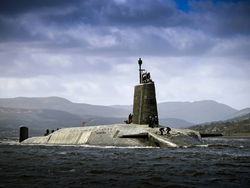 RKNV Culverin coming into Port |
Displacement: 15,900 t (submerged) Length Overall: 149.9m Beam: 12.8m Draught: 12m Complement: 135 Speed: 25kts submerged Range: Unlimited |
The Cannon-Class of ballistic missile submarines provide a continuous at sea nuclear deterrent for the Kouralian Navy. They have sixteen ballistic missile tubes, each of which can hold a missile with up to 8 warheads, and 4 torpedo tubes. | |
| Fleet Submarine | ||||
Fleet Attack Submarine ?? Hulls |
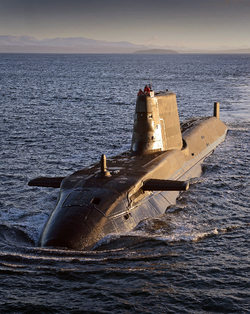 RKNV Warmaster at Sea |
Displacement: 7,600 t (submerged) Length Overall: 97m Beam: 11.3m Draught: 10m Complement: 98 Speed: 30kts submerged Range: Unlimited |
The Warmaster-Class of Fleet Attack Submarines bring a more covert anti-ship capability to Kouralian Fleets operating at a distance from shore facilities and refuelling facilities. They are faster than diesel vessels, and being significantly larger enables them to carry 38 torpedoes or land attack missiles for launch from 4 tubes. They can also carry Frogman-delivery facilities. | |
| Littoral Submarine | ||||
Littoral Attack Submarine ?? Hulls |
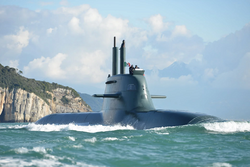 RKNV Hammerhead at Sea |
Displacement: 1,830 t (submerged) Length Overall: 57.2m Beam: 6.8m Draught: 6.4m Complement: 27 Speed: 12kts surface, 20kts submerged Range: 9,200 Miles |
The Shark-Class is a diesel and air-independent propulsion submarine class designed to operate very close to shore in highly stealthy conditions, for example to harass amphibious shipping, lay mines, or ensure delivery of naval frogmen ashore. It can operate in as little as 17m of water, and can remain submerged for as long as 18 days. The Submarine has 6 torpedo tubes, and can carry 13 torpedoes or 4-pack AA missiles capable of being launched while submerged. It can also carry up to 24 sea-mines externally. The mast contains a single recoil-less 25mm cannon which can be deployed while the vessel is submerged, and up to three short-range UAVs. | |
